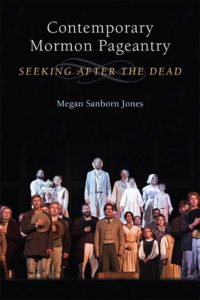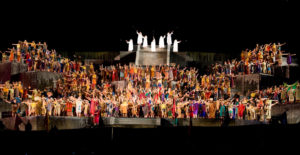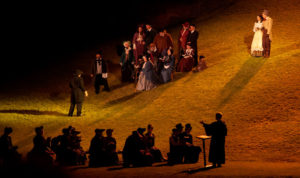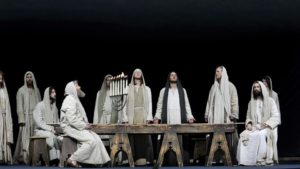 Contemporary Mormon Pageantry: Seeking After the Dead
Contemporary Mormon Pageantry: Seeking After the Dead
by Megan Sanborn Jones
University of Michigan Press, 2018
Hardbound, 318 pages, 10 pictures $80.00 (Kindle $64.95)
Reviewed by Gerald S. Argetsinger
In theatre, timing is everything. Megan Sanborn Jones’ Contemporary Mormon Pageantry: Seeking After the Dead was released October 1, 2018 and the Church of Jesus Christ of Latter-day Saints announced on October 27th its intent to “appropriately end, modify or continue existing pageants.” As of December 5, 2018, the two smaller alternating Utah pageants, the Castle Valley Pageant and Clarkson’s Martin Harris: The Man Who Knew, will end immediately. The Mormon Miracle Pageant (Manti, Utah)will end after its 2019 production and the Hill Cumorah Pageant, (America’s Witness for Christ) will end after its 2020 production. The two Nauvoo productions (A Tribute to Joseph Smith and The British Pageant), the Mesa Easter Pageant (Jesus the Christ), and the England (British Pageant) will continue. In less than one month, Contemporary Mormon Pageantry might have gone out of date if it had not been for the foresight of Jones to limit her study to snapshot-experiences gained by visiting, viewing and participating in all seven LDS pageants between 2010 and 2015. This approach, however, also eliminates all but the most basic commentary on pageant history, dramaturgy or evolving changes in aesthetics since their beginning in 1937.

Jones has made the unique choice to focus exclusively on the “production and reception of Mormon pageantry by Mormons.” (p. 3). Because of Jones’ expertise in liturgical theatre and its production, the book’s intended audience would seem to be to those with an interest in liturgical drama. However the accessibility to that audience is limited by the implications of the subtitle: Seeking After the Dead. Even though Jones begins by soundly placing Mormon pageants in the broader context of Liturgical Drama, when describing Mormon pageants she eschews traditional production vocabulary, instead co-opting the language of LDS family history and temple worship, using them to describe the creation and production process. Her treatise becomes confusing and alienating to the non-Mormon audience and very difficult for the Mormon audience. For example, rather than “creating a character,” her actors “proxy the dead;” they do not perform “historic drama,” they “resurrect history;” they do not “act their parts,” they perform “with the dead.” Even with a lifetime as both an active member of the LDS church and as a theatre professional with over thirty years experience in LDS Outdoor Drama, it was difficult for me to navigate this marriage of the vocabulary of the Plan of Salvation and temple ordinances with the vocabulary of the theatre, especially when the vocabulary is used both literally and metaphorically. The chapter titles make this clear: “The Past is Never Dead,” “Reanimating American New Pageantry,” “Performing Near the Dead: Pageant Stages and Holy Ground,” “Performing the Dead: Actors on Both Sides of the Veil,” and “Performing with the Dead: Feeling the Spirit of Holy Ghosts” (sic). Jones’ examination of Mormon pageantry as an act of temple worship, limiting her study to the experiences of volunteer Mormon participants and its reception by Mormon audiences, isolates this study from theatre professionals and scholars who will find it difficult to place in the wider context of theatre criticism and history.

Before embarking on her study, Jones justifies this “old-fashioned” art form as being appropriate for members of the LDS Church, because it is a “safe form of theatre,” somehow immune from the spiritual dangers of modern entertainment. She traces the roots of Mormon pageants back to the American New Pageantry of the early Twentieth Century and describes pageantry as an “aesthetically safe” art form that furthers the undefined “purposes of the church.” (pp. 40-41) However, Jones neglects to even mention the development of Outdoor Drama beginning in 1937, which had a far greater impact on the development of Mormon pageantry. That was the year that Pulitzer Prize winning playwright Paul Green’s production of The Lost Colony opened on Roanoke Island, North Carolina. It is the same year as the first production of an LDS Pageant, America’s Witness for Christ, at the Hill Cumorah. Both productions are still produced every summer in their same locations. These started the Outdoor Drama movement which was further marked by Paul Green’s establishment of the Institute of Outdoor Drama (IOD) at the University of North Carolina in 1963. The IOD supports historic, liturgical, classical, and Shakespearean outdoor productions and has helped develop a common vocabulary for the study of all manner of outdoor theatre.[1] Jones’ study could have benefitted from a consideration of this tradition which the Hill Cumorah Pageant helped to define.

Jones next turns to justifying the infusion of LDS vocabulary into her study of Mormon pageants for Mormons. She turns to the Oberammergau Passion Play which was first performed in a cemetery over the bodies of those who died of the Plague which rampaged Europe during the middle Seventeenth Century. She ties that tradition to the production of Mormon pageants on or near cemeteries, and from there to temple work on the behalf of the dead. Having thus established the vocabulary of her dramaturgy, she examines the productions themselves, developing the thesis that Mormon pageants impact the Mormon audience because they are inspired by the spirits of the dead who participate on stage with the actor-proxies. Summarizing her conclusion, Mormon pageants go beyond a mere aesthetic response because the Holy Ghost makes its appeal even greater. All of the elements of theatre, the staging, music, set and costume design and a unique acting style allow the audience to feel the Spirit. And so Mormon pageants resurrect the past with proxy actors that perform the dead so that the pageant participants and audience on both sides of the veil can work for their salvation. (pp. 240-43)
For Jones, actor training for pageant participants focuses exclusively on the development of spiritual experiences of the proxy performer. This reviewer finds it extremely difficult to describe those experiences in the language of seeking after our dead, or joining with the dead on stage. This seems to reduce an otherwise spiritual experience to that of mysticism wherein the actor-proxies do not develop or even portray the dead characters. In Chapter 4, “Performing the Dead”, Jones writes, “Pageant participants create characters through acts of devotion that they believe make their performance real . . . Actors in Mormon pageantry . . . believe the dead inspire them to act out their living testimonies” (p. 138). Rather than imitation, these actors employ “surrogration,” a concept described by John Roach, wherein “actors function as a ‘fetishized substitute for the corpse.’” (p. 139) “The belief in a responsibility to redeem the dead materially alters the relationship that pageant performers have to playing their roles.” (p. 139) “Pageant participants perform the dead through acts of faith, charity and devotion that help them draw nearer to Christ and to their loved ones beyond the veil.” (p. 140) “As participants personally change by offering up acts of faith, service, and devotion, they don’t need to inhabit the character. They resurrect the past as they become that which they represent.” (p.141). “Pageant performers strive to live like those that they represent . . . so that when they are on stage, they are not acting.” (p. 143) And in the end, “Participating in a pageant is a sacrifice of time, effort, personal comfort, and more, that is a reward unto itself. As they sacrifice to participate, they double the sacrifices[2] of historical disciples of Christ, the early Christians of the Book of Mormon, and early Latter-day Saints.” (p. 145) Is Jones saying here that participating in a church pageant for a couple of weeks is an equal sacrifice to being driven from your home, dying in Winter Quarters, and being caught in a blizzard with your handcart? Jones continues this line of reasoning in the section titled “There is no Artifice on Stage,” which includes detailed instruction on how to present the dead (characters), resurrect the past (perform the story), and physically bear testimony. This serious discussion ironically concludes with a description and photograph of “the expressions of sincerity,” (pp. 157-59) a set of directives that harkens back to the Delsarte theory of acting, popular in Nineteenth Century melodrama. Delsarte developed an extensive set of physical stances and gestures that supposedly conveyed all emotions and their intensities to the audience. The Mormon expressions of sincerity eliminate the need for the proxy actor to express actual emotion or testimony. In the end, it is like the old theater joke: Sincerity in performance is the most important element of acting; once you can fake that, you’ve got it made.
Jones concludes her examination of pageants by testifying to the notion that the actual spirits of characters “resurrected for each performance” actually join their “proxies” on stage, participating, in part, as a way in which they “work out their salvation.” As there is no place in theatre criticism allowing for the fantasy or reality of testimony, I will leave it to the individual reader to come to their own conclusions.
This was a very difficult book to review. It startled me that there were instance after instance of unsubstantiated claims. For example, the pageants are deemed to be “good” and “successful” for no other reason than they are produced by the Missionary Department of the LDS Church. (pp 65-68) The same department that is arguably responsible for the audience of the Hill Cumorah Pageant dwindling from 73,000 in attendance in 1997 down to roughly 25,000 after they took control of the production.[3] Let me conclude by tackling one statement that causes me to just shake my head. Without any supporting evidence, Jones twice claims that LDS Church pageants produced under the direction of the Missionary Department “alone qualify the Church as the largest producer of organized religious theater in America.” (pp. 9 and 39). In reality, they don’t even come close. The Sight and Sound Theater in Lancaster, Pennsylvania singularly produces Christian theatre on a larger scale than all LDS Pageants combined. In this one location they sell 800,000 tickets per year. That is doubled by its sister theater in Branson, Missouri. The Alliance for Jewish Theater represents Jewish theme plays that reach more audience members monthly than an entire season of LDS Pageants. The Eureka Springs, Arkansas Passion Play is just one of a network of Protestant productions about the life of Jesus Christ that are performed annually for hundreds of thousands of audience members. The LDS Church is the poor sister insofar as liturgical play production is concerned.
Megan Sanborn Jones is rightfully a highly respected scholar. Here her dramaturgy is grounded in unique Mormon doctrine rather than theatre history, performance vocabulary or literary traditions. The result is an exclusively Mormon reading of Church Pageants isolated from the wider scholarly literature.
[1]Moe, Christian H. & Scott J. Parker. Creating Historical Drama, 2nd Edition. Carbondale, IL: Southern Illinois University Press, 2005.
[2]Italics added
[3]Archived pageant records in the author’s possession.
GERALD S. ARGETSINGER (Professor of Cultural and Creative Studies, Rochester Institute of Technology, retired) worked for 30 years in Outdoor Drama. He served as Artistic Director of America’s Witness for Christ (Manchester, NY), Equality of Rights: the First Women’s Rights Convention (Women’s Rights National Historical Park, Seneca Falls, NY), Trail of the Lonesome Pine (Big Stone Gap, VA), Utah! (Tuachan, St. George, UT), Sword of Peace and Pathway to Freedom (Snow Camp, NC). He served in the Presidency of the Hill Cumorah Pageant and was its Artistic Director 1990–97. He is the founder of the Gay Mormon Literature Project and lead editor of Latter Gay Saints: An Anthology of Gay Mormon Fiction (2014). He has published extensively on Scandinavian literature and scores of theatre topics. His plays are represented by Leicester Bay Theatricals. His callings include ward and stake Young Men’s Presidencies, Stake High Council, ward Sunday School President, and currently as a counselor in a bishopric. B.A. (Theater) Brigham Young University, Ph.D. (Dramaturgy & directing) Bowling Green State University, Ohio. He is married to Gail Bishop Argetsinger and they have two adult children.
